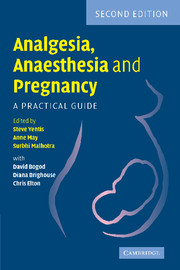Book contents
- Frontmatter
- Contents
- List of contributors
- Preface
- SECTION 1 PRECONCEPTION AND CONCEPTION
- SECTION 2 PREGNANCY
- I Procedures in early/mid-pregnancy
- II Normal pregnancy and delivery
- III Operative delivery and third stage
- IV Anaesthetic complications
- V Problems confined to obstetrics
- VI Problems not confined to obstetrics
- VII The neonate
- SECTION 3 PUERPERIUM AND AFTER
- SECTION 4 ORGANISATIONAL ASPECTS
- Index
SECTION 3 - PUERPERIUM AND AFTER
Published online by Cambridge University Press: 10 November 2010
- Frontmatter
- Contents
- List of contributors
- Preface
- SECTION 1 PRECONCEPTION AND CONCEPTION
- SECTION 2 PREGNANCY
- I Procedures in early/mid-pregnancy
- II Normal pregnancy and delivery
- III Operative delivery and third stage
- IV Anaesthetic complications
- V Problems confined to obstetrics
- VI Problems not confined to obstetrics
- VII The neonate
- SECTION 3 PUERPERIUM AND AFTER
- SECTION 4 ORGANISATIONAL ASPECTS
- Index
Summary
DRUGS AND BREASTFEEDING
Mothers often ask their anaesthetist for information about breastfeeding after anaesthetic and surgical interventions. The majority of drugs administered to the mother enter her breast milk but many are present in pharmacologically insignificant amounts and do not therefore pose a risk to the baby. The amount of drug that a breastfed baby receives is dependent on the concentration of drug in the milk and the volume of milk taken by the baby. In the first few days following delivery, the baby receives colostrum and then very small volumes of milk, so that any drug exposure is likely to be minimal. It is, however, common sense to administer drugs to the breastfeeding mother only if they are considered essential.
The British National Formulary (BNF) contains a comprehensive list of drugs that are known to be present in breast milk following maternal administration, but also points out that in many cases there are insufficient data to enable accurate information to be provided.
Breastfeeding and anaesthesia
Production of breast milk is dependent on adequate maternal hydration and regular stimulation (either by the baby feeding or by the mother expressing her milk). A mother scheduled for anaesthesia and surgery should be encouraged to feed her baby as near as possible to the planned time of surgery and also as soon as she feels able to postoperatively. In some cases it may be more appropriate for her to express milk in the early postoperative period.
- Type
- Chapter
- Information
- Analgesia, Anaesthesia and PregnancyA Practical Guide, pp. 337 - 344Publisher: Cambridge University PressPrint publication year: 2007



